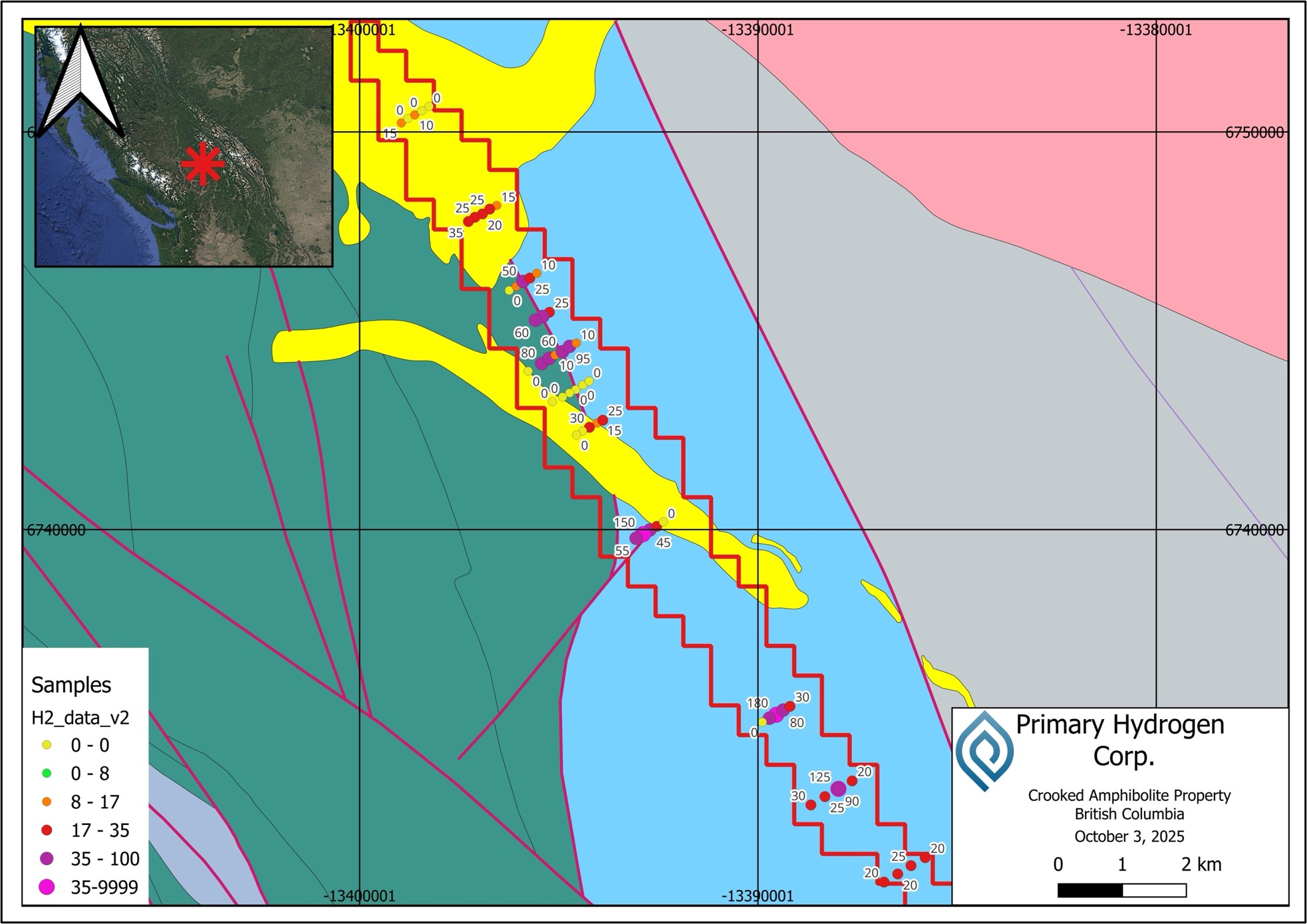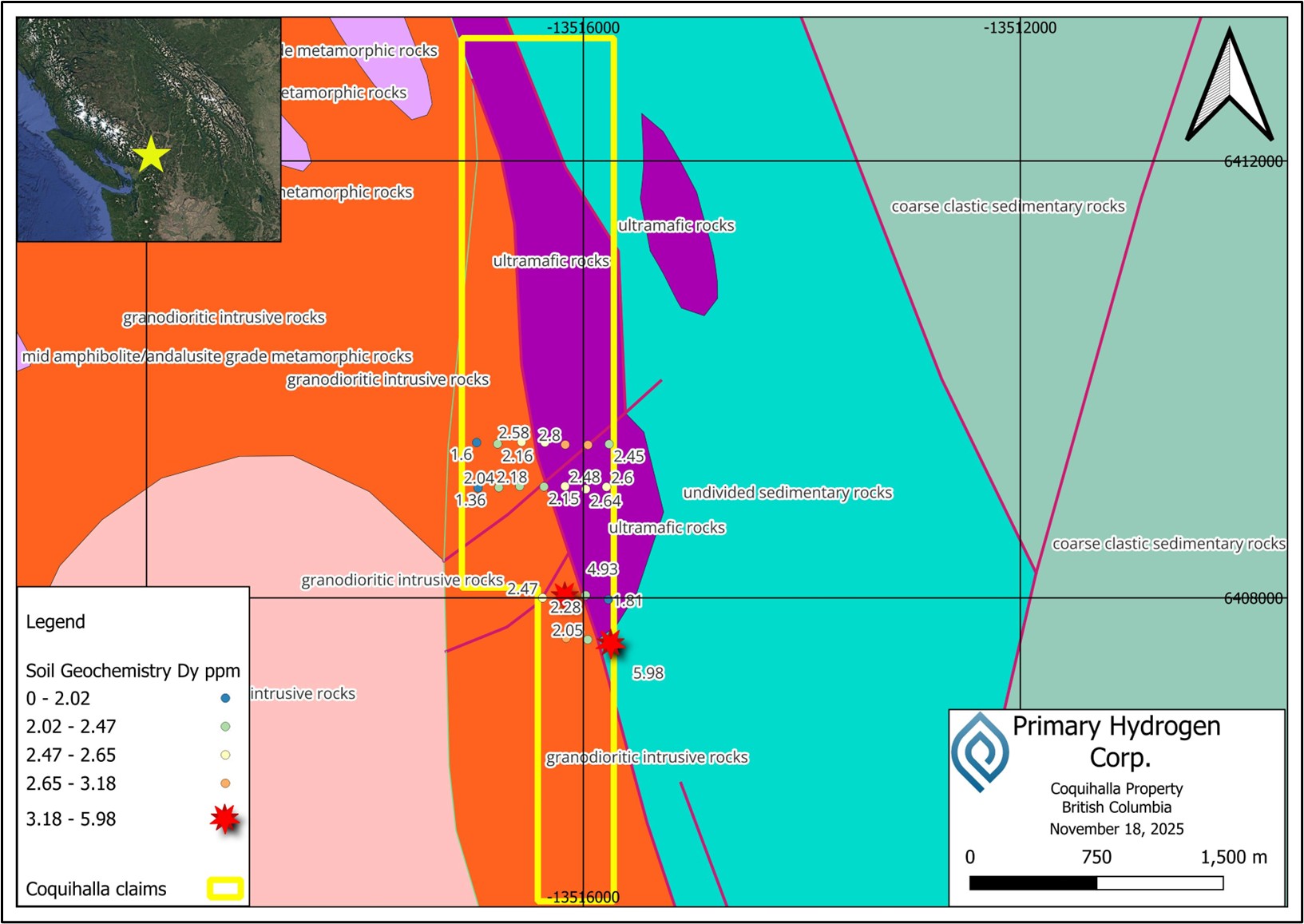Primary Hydrogen Identifies 8-Kilometre Hydrogen Anomaly at Crooked Amphibolite Project In British Columbia
Primary Hydrogen (OTCQB:HNATF) reported soil gas and soil geochemistry results from its British Columbia BC H2 Projects on Nov 24, 2025. The Crooked Amphibolite property returned an approximately 8-kilometre linear trend of elevated hydrogen with values up to 180 ppm, interpreted to align with fault structures and possible serpentinization at depth. The Coquihalla property produced a HREE soil anomaly of 170 ppm TREO coincident with a magnetic high. The program covered 3,346 acres with 41 soil samples and used INRS-validated methods to minimize artificially generated hydrogen. Company notes further sampling is required to refine targets and validate interpretations.
Primary Hydrogen (OTCQB:HNATF) ha riportato risultati di gas del suolo e geochimica del suolo dai suoi progetti H2 BC in British Columbia BC il 24 novembre 2025. La proprietà Crooked Amphibolite ha mostrato una tendenza lineare di circa 8 chilometri di idrogeno elevato con valori fino a 180 ppm, interpretata in linea con strutture di fault e possibile serpentinizzazione in profondità. La proprietà Coquihalla ha prodotto una anomalia HREE del suolo di 170 ppm TREO coincidente con un picco magnetico. Il programma ha coperto 3.346 acri con 41 campioni di suolo e ha utilizzato metodi validati dall'INRS per minimizzare l'idrogeno generato artificialmente. L'azienda segnala che ulteriori campionamenti sono necessari per affinare i target e validare le interpre‑tazioni.
Primary Hydrogen (OTCQB:HNATF) informó resultados de gas del suelo y gequímica del suelo de sus Proyectos H2 BC en British Columbia BC el 24 de noviembre de 2025. La propiedad Crooked Amphibolite mostró una tendencia lineal de aproximadamente 8 kilómetros de hidrógeno elevado con valores de hasta 180 ppm, interpretada para alinearse con estructuras de falla y posible serpentinización en profundidad. La propiedad Coquihalla produjo una anomalía de HREE en el suelo de 170 ppm TREO coincidente con un Pico magnético. El programa cubrió 3.346 acres con 41 muestreos de suelo y utilizó métodos validados por INRS para minimizar el hidrógeno generado artificialmente. La empresa señala que se requieren más muestreos para refinar objetivos y validar interpretaciones.
Primary Hydrogen (OTCQB:HNATF)는 브리티시컬럼비아 BC H2 프로젝트의 토양 가스와 토양 지구화학 결과를 2025년 11월 24일에 발표했습니다. Crooked Amphibolite 부지는 약 8km의 고수소선형 경향을 보였고 값은 최대 180 ppm까지 나왔으며 단층 구조 및 깊은 곳의 가능성 있는 세르펜티나이제이션과 일치하는 것으로 해석됩니다. Coquihalla 부지는 170 ppm TREO의 HREE 토양 이상을 자성 고점과 일치시켰습니다. 이 프로그램은 3,346에이커를 다루었고 41개의 토양 샘플을 채취했으며 인RS-검증 방법을 사용해 인위적으로 생성된 수소를 최소화했습니다. 회사는 표적을 세밀화하고 해석을 검증하기 위해 추가 샘플링이 필요하다고 언급했습니다.
Primary Hydrogen (OTCQB:HNATF) a rapporté des résultats de gaz du sol et de géochimie du sol de ses projets H2 BC en Colombie-Britannique BC le 24 novembre 2025. La propriété Crooked Amphibolite a présenté une tendance linéaire d’environ 8 kilomètres d’hydrogène élevé avec des valeurs allant jusqu’à 180 ppm, interprétée comme alignée avec des structures de faille et une possible serpentinisat ion en profondeur. La propriété Coquihalla a produit une anomalie de sol HREE de 170 ppm TREO coïncidant avec un sommet magnétique. Le programme a couvert 3 346 acres avec 41 échantillons de sol et a utilisé des méthodes validées par l’INRS pour minimiser l’hydrogène généré artificiellement. L’entreprise indique que des échantillonnages supplémentaires sont nécessaires pour affiner les cibles et valider les interprétations.
Primary Hydrogen (OTCQB:HNATF) berichtete Boden-Gas- und Bodengeochemie-Ergebnisse aus seinen BC H2-Projekten in British Columbia BC am 24. November 2025. Die Crooked Amphibolite-Fläche zeigte eine ungefähr 8 Kilometer lange lineare Trendlinie mit erhöhtem Wasserstoffgehalt bis zu 180 ppm, interpretiert als Übereinstimmung mit Bruchstrukturen und möglicher Serpentinisierung in der Tiefe. Die Coquihalla-Fläche zeigte eine HREE-Bodensanomalie von 170 ppm TREO korespondierend mit einem magnetischen Hoch. Das Programm umfasste 3.346 Acres mit 41 Bodenproben und verwendete INRS-validierte Methoden, um künstlich erzeugten Wasserstoff zu minimieren. Das Unternehmen weist darauf hin, dass weitere Probenahmen erforderlich sind, um Ziele zu verfeinern und Interpretationen zu validieren.
Primary Hydrogen (OTCQB:HNATF) أبلغ عن نتائج غاز التربة والكيمياء التربة من مشاريعه BC H2 في كولومبيا البريطانية BC في 24 نوفمبر 2025. أظهرت ملكية Crooked Amphibolite مساراً خطياً يبلغ نحو 8 كيلومترات من الهيدروجين المرتفع بقيم تصل إلى 180 جزءاً في المليون، كما فُسِّرت على أنها تت align مع هياكل صدع وبرودة serpentinization عند العمق. أخرجت ملكية Coquihalla تشوّهاً في التربة بـ 170 ppm TREO يتزامن مع ارتفاع مغناطيسي. غطّى البرنامج 3,346 فداناً مع 41 عينة تربة واستخدم أساليب معتمدة من INRS لتقليل الهيدروجين الناتج صناعياً. وتورد الشركة أن جمع عينات إضافية مطلوب لتحديد الأهداف والتحقق من التفسيرات.
- Hydrogen anomaly up to 180 ppm along an 8-km trend
- HREE soil anomaly of 170 ppm TREO at Coquihalla
- Program covered 3,346 acres with 41 soil samples using INRS-validated methods
- Sampling gap mid‑trend due to saturated ground prevented full coverage
- No above‑background hydrogen at Coquihalla; only one above‑background sample at Cogburn
- Results are preliminary and Company states additional, closer‑spaced sampling is required
CALGARY, AB / ACCESS Newswire / November 24, 2025 / Primary Hydrogen Corp. (TSXV:HDRO)(FRA:83W0)(OTCQB:HNATF) (the "Company" or "Primary Hydrogen") is pleased to announce results from its field sampling program at the Crooked Amphibolite, Coquihalla, and Cogburn projects (collectively the "BC H2 Projects") in British Columbia, Canada. The program identified an approximately 8-kilometre-long trend of elevated hydrogen readings at the Crooked Amphibolite Property, with values up to 180 ppm, as well as an anomalous heavy rare earth element (HREE) zone at the Coquihalla Property with total rare earth oxides (TREO) of 170 ppm.
Program Highlights:
Crooked Amphibolite Property: Multiple hydrogen readings up to 180 ppm along an ~8-kilometre trend, spatially associated with interpreted fault structures
Anomalous hydrogen values appear to align with major structural features, suggesting active serpentinization at depth and possible fault-controlled hydrogen migration
Coquihalla Property: Soil samples revealed HREE anomaly (170 ppm TREO) coincident with a magnetic high, warranting follow-up investigation
Sampling completed over 3,346 acres across three properties using INRS-validated techniques designed to minimize artificially generated hydrogen
Results support the geological model for natural hydrogen generation in serpentinized ultramafic terranes
"The Crooked Amphibolite property has delivered encouraging results with hydrogen readings up to 180 ppm distributed along an 8-kilometre trend," stated Peter Lauder, Vice President of Exploration at Primary Hydrogen Corp. "The linear distribution of these anomalies along interpreted fault structures is consistent with our geological model for natural hydrogen generation through serpentinization at depth. This validates our targeting approach and positions Crooked Amphibolite as one of British Columbia's most prospective natural hydrogen exploration targets. The discovery of a HREE soil anomaly at Coquihalla adds further value to our BC portfolio and demonstrates the multi-commodity potential of these ultramafic-hosted terranes."
Program Overview
The field sampling program was conducted by Tripoint Geological Services under the supervision of Peter Lauder, P.Geo., VP of Exploration, and was completed in Q3/2025. The program utilized sampling techniques designed and tested by the Institut National de la Recherche Scientifique (INRS) to minimize artificially produced hydrogen. A total of 41 soil samples and numerous soil gas measurements were collected across the three properties, covering an aggregate area of 3,346 acres.
Crooked Amphibolite Property - Soil Gas Results
The Crooked Amphibolite Property geology is dominated by serpentinized mafic and ultramafic rocks, which represent key indicators of naturally occurring hydrogen (NOH) potential. The serpentinization process-whereby ultramafic rocks react with water at elevated temperatures-is well-established as a source of hydrogen. The property is structurally complex, with major thrust faults and strike-slip faults crisscrossing the region. These faults can act as both migration pathways for hydrogen and potential accumulation mechanisms, particularly where they intersect serpentinized ultramafic bodies.
Figure 1: Crooked Amphibolite Property - Soil Gas Hydrogen Results

Multiple sampling stations on the Crooked Amphibolite Property yielded elevated hydrogen readings with values up to 180 ppm, distributed along an approximately 8-kilometre trend (see Figure 1). The trend is interrupted near the center of the property by a gap where saturated ground conditions prevented optimal gas sampling. The highest hydrogen values are typically surrounded by moderate values, suggesting gradual dissipation away from source zones. The linear nature of the anomalous readings suggests that an active fault system may be tapping into zones of active serpentinization at depth and potentially acting as a conduit for hydrogen migration.
The Company believes that additional sampling will be required to further define the extent and intensity of the hydrogen anomaly. Employing sampling techniques pioneered by Primary Hydrogen and INRS, the Company may undertake closer-spaced sampling and utilize alternative probe types to validate and refine the initial observations.
Coquihalla Property - Soil Sampling Results
Soil samples collected from the central portion of the northern claim area on the Coquihalla Property revealed an anomalous concentration of heavy rare earth elements with a TREO value of 170 ppm. This anomaly is spatially correlated with a magnetic high and may be attributed to enrichment associated with adjacent ultramafic units. Alternatively, these soil anomalies could be indicative of an undiscovered rare earth element deposit. Further sampling and analysis will be required to validate this hypothesis and determine the source and significance of the HREE enrichment.
Figure 2: Coquihalla Property - Dysprosium in Soils

Despite the presence of serpentinized ultramafic rocks situated along fault structures, the Coquihalla Property yielded no above-background hydrogen readings in soil gas sampling. Similarly, the Cogburn Property produced only one sample with hydrogen values above background levels (175 ppm). Soil geochemistry results across all properties showed no correlation between hydrogen values and other elements analyzed, which is consistent with hydrogen's high mobility and tendency to rapidly escape to the atmosphere.
Exploration Program Methodology
The exploration program integrated portable gas detectors (Dräger X-am 8000) for immediate in-field measurements with conventional geological exploration techniques, including soil sampling, prospecting, and geological mapping. Soil gas sampling involves the collection and analysis of gases present in soil pores near the surface, helping to detect anomalies potentially indicative of subsurface hydrogen accumulations. This integrated approach is specifically aimed at efficiently identifying the presence of natural hydrogen at surface levels while simultaneously refining the Company's geological understanding of potential hydrogen generation sources, migration pathways, and accumulation zones.
Primary Hydrogen's sampling methodology and procedures have been collaboratively developed with INRS, leveraging laboratory-verified techniques to ensure consistent, reliable results and minimize artificially generated hydrogen. The collected data will inform subsequent exploration phases and increase confidence in the identification and evaluation of prospective natural hydrogen targets.
Qualified Person
The technical information in this news release has been reviewed and approved by Mr. Peter Lauder, P.Geo., V.P. Exploration for Primary Hydrogen Corp. Mr. Lauder is the Qualified Person responsible for the scientific and technical information contained herein under National Instrument 43-101 standards.
About Primary Hydrogen Corp.
Primary Hydrogen is dedicated to the exploration and development of natural hydrogen resources. With over 740 acres in the U.S. and 230 square kilometers across Canada, the Company's portfolio includes the Blakelock, Hopkins, Mary's Harbour, Point Rosie, Crooked Amphibolite, Coquihalla, and Cogburn projects. Primary has an option to acquire a
FOR FURTHER INFORMATION PLEASE CONTACT:
Ben Asuncion
Chief Executive Officer
Primary Hydrogen Corp.
Email: ben@primaryh2.com
CAUTIONARY NOTE REGARDING FORWARD-LOOKING INFORMATION
This news release contains "forward-looking information" and "forward-looking statements" within the meaning of applicable Canadian securities laws. Forward-looking statements in this release include statements regarding: (i) the interpretation and significance of exploration results, including the potential for natural hydrogen generation through serpentinization at depth; (ii) the prospectivity of the Crooked Amphibolite Property for natural hydrogen exploration; (iii) the potential source and significance of HREE soil anomalies at the Coquihalla Property; (iv) plans for additional sampling and investigation to validate exploration results and refine geological models; (v) the effectiveness of sampling methodologies developed with INRS; and (vi) the use of collected data to inform future exploration phases.
Forward-looking statements can generally be identified by the use of words such as "may," "will," "could," "believes," "expects," "intends," "plans," "potential," "projects," "suggests," or similar expressions. These statements are based on assumptions made by the Company regarding, among other things: the accuracy and reliability of sampling results; the validity of geological interpretations; the effectiveness of exploration methodologies; continued availability of funding and resources; timely receipt of necessary permits and approvals; and the absence of unforeseen operational issues or other impediments.
Forward-looking statements involve significant risks and uncertainties that could cause actual outcomes to differ materially from those projected. Such risks include, but are not limited to: uncertainties inherent in the interpretation of exploration results; the preliminary nature of soil gas and soil geochemistry sampling; potential inaccuracies or inconsistencies in sampling results; inability to secure necessary permits or regulatory approvals for future work; potential logistical or environmental challenges; unforeseen operational issues or increased costs; failure to identify economic concentrations of natural hydrogen or rare earth elements; and other general economic, market, regulatory, or geological risks detailed in the Company's public disclosure filings available on SEDAR+ at www.sedarplus.ca.
Although the Company believes its expectations and assumptions are reasonable based on current information, there can be no assurance that these forward-looking statements will prove accurate. Readers should not place undue reliance on forward-looking statements or information, as actual outcomes may vary materially from those anticipated. The Company undertakes no obligation to update forward-looking information except as required by applicable securities laws.
Neither the TSX Venture Exchange nor its Regulation Services Provider (as that term is defined in policies of the TSX Venture Exchange) accepts responsibility for the adequacy or accuracy of this release.
SOURCE: Primary Hydrogen Corp.
View the original press release on ACCESS Newswire







